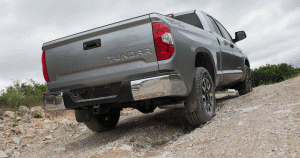 You’ve decided to buy a Toyota truck, a smart choice thanks to Toyota’s legendary value, dependability, and rugged curb appeal. Now the big question remains — should you choose the Tacoma or the Tundra? Both have their advantages, so your decision should depend on what your purposes and motivations are.
You’ve decided to buy a Toyota truck, a smart choice thanks to Toyota’s legendary value, dependability, and rugged curb appeal. Now the big question remains — should you choose the Tacoma or the Tundra? Both have their advantages, so your decision should depend on what your purposes and motivations are.
Price
If budgetary concerns are a major factor, consider the MSRPs of these two trucks. The 2017 Tacoma starts at $24,210 for base models but retails for over $40,000 for higher-end trims such as the TRD Pro. The 2017 Tundra, on the other hand, starts at $30,020, with upper trims such as the Platinum in the $50,000 range.
Don’t disregard other financial considerations, such as the cost of insurance, which is naturally higher for the Tundra since it’s a more expensive vehicle. Fuel efficiency is a vital long-term factor as well. The Tacoma gets 19 miles per gallon in the city and 23 on the highway when equipped with the fuel-efficient 2.7-liter four-cylinder. The Tundra gets about 14 mpg in the city and 18 on the highway when sporting the base 4.6-liter engine.
Size
A big truck is handy for hauling, but a bit more difficult to park and maneuver. If most of your driving takes place in the city, the Tacoma may be a better choice. It’s about half a foot slimmer than the Tundra, and around 17 inches shorter. Tundra long beds are about 3 feet longer than the Tacoma’s. The Tundra also has a turning radius that’s a couple of feet longer than the Tacoma, making U-turns more challenging.
If you intend on loading lots of stuff in the back, Tundra is the clear winner. The Tundra short bed is a foot-and-a-half longer, over two feet wider, and 3 inches deeper than the Tacoma’s bed. Opting for a Tundra long bed gives you a 3-foot advantage over the Tacoma.
Performance
The Tacoma and Tundra differ vastly in terms of power and hauling capabilities. The base Tacoma gets 159 horsepower, with larger engines pushing out 278 horses. A basic Tundra starts off at 310 horses but can crank out up to 381. Both trucks are available in a TRD trim for off-roading purposes.
Payload capacity may be a factor for you, especially if the truck will be used for construction or heavy-duty hauling. The Tacoma is no slouch, capable of payloads ranging from 1,120 to 1,620 pounds depending on trim, engine size, and features. The Tundra, however, can haul at least 1,440 pounds, with a whopping 2,080-pound payload capacity at the upper end.
Both trucks are awesome for towing, with some trims offering tow packages and integrated trailer brake controllers as standard features. The Tacoma can pull up to 3,500 pounds. If you have serious towing, however, consider the Tundra. It can tow anywhere from 6,400 to 10,500 pounds.
While it’s tempting to decide by flipping a coin, there are better ways to choose between these two excellent trucks. It’s all a matter of what you need from your new pickup. With a wealth of trim and accessory options, you’re sure to get exactly what you want.
-
MSRP excludes the Delivery, Processing and Handling Fee of $865 for cars, $940 for small/medium trucks (Sienna, RAV4 Gas, RAV4 Hybrid, Highlander Gas, Highlander Hybrid, 4Runner & Tacoma), $1095 for Large SUVs (Sequoia, Land Cruiser) and $1195 for Large Truck (Tundra) (Historically, vehicle is called the “Delivery, Processing and Handling Fee and is based on the value of the processing, handling and delivery services Toyota provides as well as Toyota’s overall pricing structure. Toyota may make a profit on the Delivery, Processing and Handling Fee.) Excludes taxes, license, title and available or regionally required equipment. The Delivery, processing and Handling Fee in AL, AR, FL, GA, LA, MS, NC, OK. SC & TX will be higher. Actual dealer price will vary.
Image via Toyota.com



